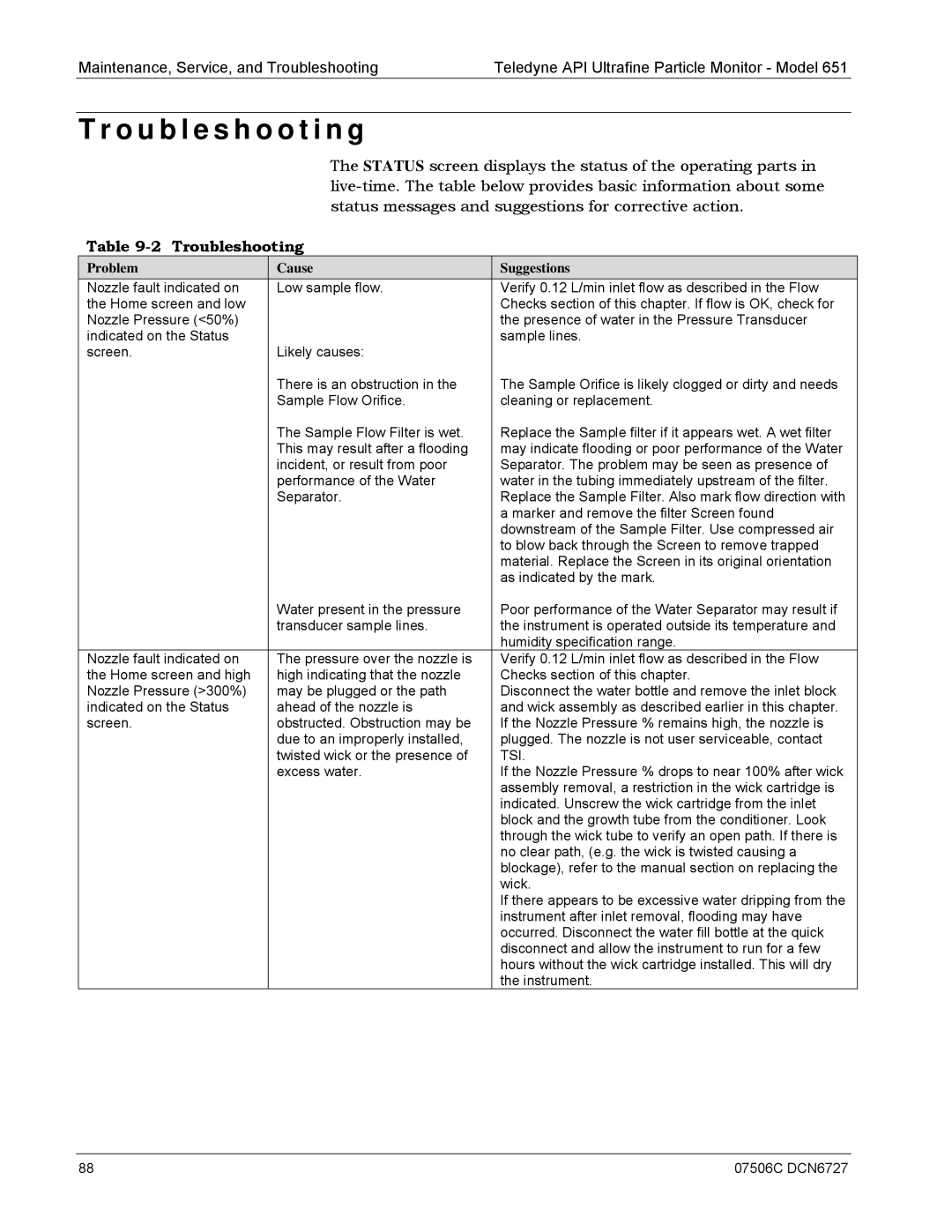
Maintenance, Service, and TroubleshootingTeledyne API Ultrafine Particle Monitor - Model 651
T r o u b l e s h o o t i n g
The STATUS screen displays the status of the operating parts in
Table 9-2 Troubleshooting
Problem | Cause | Suggestions |
Nozzle fault indicated on | Low sample flow. | Verify 0.12 L/min inlet flow as described in the Flow |
the Home screen and low |
| Checks section of this chapter. If flow is OK, check for |
Nozzle Pressure (<50%) |
| the presence of water in the Pressure Transducer |
indicated on the Status |
| sample lines. |
screen. | Likely causes: |
|
| There is an obstruction in the | The Sample Orifice is likely clogged or dirty and needs |
| Sample Flow Orifice. | cleaning or replacement. |
| The Sample Flow Filter is wet. | Replace the Sample filter if it appears wet. A wet filter |
| This may result after a flooding | may indicate flooding or poor performance of the Water |
| incident, or result from poor | Separator. The problem may be seen as presence of |
| performance of the Water | water in the tubing immediately upstream of the filter. |
| Separator. | Replace the Sample Filter. Also mark flow direction with |
|
| a marker and remove the filter Screen found |
|
| downstream of the Sample Filter. Use compressed air |
|
| to blow back through the Screen to remove trapped |
|
| material. Replace the Screen in its original orientation |
|
| as indicated by the mark. |
| Water present in the pressure | Poor performance of the Water Separator may result if |
| transducer sample lines. | the instrument is operated outside its temperature and |
|
| humidity specification range. |
Nozzle fault indicated on | The pressure over the nozzle is | Verify 0.12 L/min inlet flow as described in the Flow |
the Home screen and high | high indicating that the nozzle | Checks section of this chapter. |
Nozzle Pressure (>300%) | may be plugged or the path | Disconnect the water bottle and remove the inlet block |
indicated on the Status | ahead of the nozzle is | and wick assembly as described earlier in this chapter. |
screen. | obstructed. Obstruction may be | If the Nozzle Pressure % remains high, the nozzle is |
| due to an improperly installed, | plugged. The nozzle is not user serviceable, contact |
| twisted wick or the presence of | TSI. |
| excess water. | If the Nozzle Pressure % drops to near 100% after wick |
|
| assembly removal, a restriction in the wick cartridge is |
|
| indicated. Unscrew the wick cartridge from the inlet |
|
| block and the growth tube from the conditioner. Look |
|
| through the wick tube to verify an open path. If there is |
|
| no clear path, (e.g. the wick is twisted causing a |
|
| blockage), refer to the manual section on replacing the |
|
| wick. |
|
| If there appears to be excessive water dripping from the |
|
| instrument after inlet removal, flooding may have |
|
| occurred. Disconnect the water fill bottle at the quick |
|
| disconnect and allow the instrument to run for a few |
|
| hours without the wick cartridge installed. This will dry |
|
| the instrument. |
88 | 07506C DCN6727 |
